Upcoming Events:
- VCF South West - June 14 - 16, Davidson-Gundy Alumni Center at University of Texas at Dallas
- VCF West - Aug 2 - 3, Computer History Museum, Mountain View, CA
- VCF Midwest - Sept 7 - 8 2024, Schaumburg, IL
- VCF SoCal - Mid February 2025, Location TBD, Southern CA
- VCF East - April 2025, Infoage Museum, Wall NJ
-
Please review our updated Terms and Rules here
You are using an out of date browser. It may not display this or other websites correctly.
You should upgrade or use an alternative browser.
You should upgrade or use an alternative browser.
Matrox E-VDP
- Thread starter NeXT
- Start date
RWallmow
Veteran Member
lol that's interesting but nope not from me. I'd be curious who it may have been though.
I figured, I am going to go with that its some spam my filter didn't catch, but it was just really funny timing, lol
And since the sender of that obviously was on this post, to them, yeah, I am not going to reply or publish a post with every other letter alternating upper/lower case, lol
RWallmow
Veteran Member
Yes it was, name matches what he submitted.
That's who I was about to suggest as well but got distracted googling around for them lol. While we harped on him pretty hard, it's (remotely) possible he just grabbed that picture as an example. Either way if they had some pics of their unit and not NeXT's it's possible. Mine is also former gov't property.
NeXT
Veteran Member
I ran out of space at my old apartment to work on the system but now that I'm setup again back home I have no reason to do a complete teardown now and begin a proper inspection. I have a spare AT power supply now so I can also see if my POST problem is the fault of the power supply or more shorting tantalum caps. Failing that I'll have to wait a little longer for my logic analyzer to come in from qbus and start seeing if it's doing much of anything at all. I'll take the chance to dump the hard drive before the Connor's seal fails. Whatever is on that drive will probably be impossible to find again.
NeXT
Veteran Member
Pulled it apart and backed up the hard drive. It was partitioned into two separate drives and had a bunch of games on top of a few other suspicious folders on it I'll investigate later.
While running the backup I powered the drive from the sysem's power supply. The power supply squeals constantly and changes in octave when the drive is busy. I was having suspicious voltage issues before and I think it's now safe to say that at the very least the PSU needs a recap. The wiring is slightly different from a regular AT power supply so I cannot easily test with a substitute.
While running the backup I powered the drive from the sysem's power supply. The power supply squeals constantly and changes in octave when the drive is busy. I was having suspicious voltage issues before and I think it's now safe to say that at the very least the PSU needs a recap. The wiring is slightly different from a regular AT power supply so I cannot easily test with a substitute.
commodorejohn
Veteran Member
What was this thing intended for, anyway? Were there Laserdisc games like certain arcade titles, or what?
NeXT
Veteran Member
There were a few educational and encyclopedia laserdiscs that contained footage cued by an included software package. The idea was that you connected the player to the computer and if you for example wanted to see a video of a rocket launching the program would cue the player to a certain frame and play. In some packages you had a card which overlayed the video on your CGA or VGA monitor with the text component that was on the hard drive. Mind you the hardware was extremely expensive. When CD's came around people just started stuffing everything into one disc.
Dragon's Lair is infamously an arcade classic that ran off a laserdisc player inside the cabinet.
There was also of course the Halcyon.
http://www.youtube.com/watch?v=yTDz4epLULQ
Edited: Here's a dump of the hard drive in case anyone wants to poke through a time capsule but it looks like over the years the drive saw a format and all the original control software was lost unless I somehow missed it.
MSE is also bitching about VFAT.exe in the /norton directory so don't do anything dumb just in case.
Dragon's Lair is infamously an arcade classic that ran off a laserdisc player inside the cabinet.
There was also of course the Halcyon.
http://www.youtube.com/watch?v=yTDz4epLULQ
Edited: Here's a dump of the hard drive in case anyone wants to poke through a time capsule but it looks like over the years the drive saw a format and all the original control software was lost unless I somehow missed it.
MSE is also bitching about VFAT.exe in the /norton directory so don't do anything dumb just in case.
Last edited:
the Laserdisc RS-232 control system was generally standardized. I think at most there were 2-3 protocols with Pioneer's system being dominant. I would be more concerned about how to control the video overlay card in the system. They usually need a way to be told the "key" color.
Apple tried a similar setup with the Apple IIgs by combining the Video Overlay Card and a serial cable run to a Laserdisc player. GS/OS System 6 had a standardized media controller system built into it to run the player. The goal was to create an interactive educational system using Hypercard or Hyper Studio to build the applications.
Apple tried a similar setup with the Apple IIgs by combining the Video Overlay Card and a serial cable run to a Laserdisc player. GS/OS System 6 had a standardized media controller system built into it to run the player. The goal was to create an interactive educational system using Hypercard or Hyper Studio to build the applications.
Mine was likely used for training. As others said, the computer could control the laserdisc player and select a track to play based on your input or results. You could have an interactive test, an encyclopedia was a common one (I believe at least Amiga had this -with video clips), or other training/sales material. Sorta ideal for an interactive museum display. I have one laserdisc (actually my only interactive one) from IBM regarding some internal training info, I never ended up with anything to watch it with. It can play on a regular laserdisc player but it's not really in order.
Several arcade video games also used laser discs. Dragon's Lair was the most popular one I'd like to find. I *think* that "old" 3d video (video was projected to the center of the round console) game .. trying to remember the names, one was a cowboy shooter and the other I think was a time traveler game. Interactive video footage, mostly so you could try and hit the "fire" button before the computer.
Several arcade video games also used laser discs. Dragon's Lair was the most popular one I'd like to find. I *think* that "old" 3d video (video was projected to the center of the round console) game .. trying to remember the names, one was a cowboy shooter and the other I think was a time traveler game. Interactive video footage, mostly so you could try and hit the "fire" button before the computer.
RWallmow
Veteran Member
...Several arcade video games also used laser discs. Dragon's Lair was the most popular one I'd like to find. I *think* that "old" 3d video (video was projected to the center of the round console) game .. trying to remember the names, one was a cowboy shooter and the other I think was a time traveler game. Interactive video footage, mostly so you could try and hit the "fire" button before the computer.
I remember an early interactive video "cowboy shooter" one too, cant recall the name of it off hand, but I though that one was one of the earliest/first mpeg CD-ROM video titles, cabinet had mpeg playback hardware. Or maybe I am thinking of a later remake of the same type of concept. Wish I could think of the name of it, played it all the time as a kid, lol.
Mad Dog McCree. It used an Amiga 500 to control the Laserdisc player.
http://en.wikipedia.org/wiki/Mad_Dog_McCree
http://www.bboah.com/index.php?action=artikel&cat=7&id=5&artlang=en
http://en.wikipedia.org/wiki/Mad_Dog_McCree
http://www.bboah.com/index.php?action=artikel&cat=7&id=5&artlang=en
NeXT
Veteran Member
Work has resumed.
Initial testing was to see what the voltage rails were like without any load. +5, -5 and -12 were in spec but +12 is only 11.2v until I attached a hard drive and that oulled it up to 11.8v (still low but just within limits). At the very least though the PSU is behaving well enough to resume testing.
Starting with the backplane I found and removed two shorted tantalum capacitors on the -12v rail, clearing the short we had previously found. When reinstalled however all but the +5 was coming up immediately, until another tant that had not been reporting itself as shorting blew itself apart. I checked all those tants. Why did you decide to still give out?? Removed that one and tried again. All four voltages came up but suddenly -12 vanished again. Sure enough, another tant on the board had shorted out. I'm amazed the PSU is not kicking out with these near 0 ohm shorts. Removed it AGAIN, let the PSU run with the backplane and a load on the power rails and so far things are stable so I think we got them all.
I only briefly checked the three ISA cards but it appears the SBC and VGO boards also have ground-to-rail shorts. I'll deal with those once the backplane stops screwing with me.
Initial testing was to see what the voltage rails were like without any load. +5, -5 and -12 were in spec but +12 is only 11.2v until I attached a hard drive and that oulled it up to 11.8v (still low but just within limits). At the very least though the PSU is behaving well enough to resume testing.
Starting with the backplane I found and removed two shorted tantalum capacitors on the -12v rail, clearing the short we had previously found. When reinstalled however all but the +5 was coming up immediately, until another tant that had not been reporting itself as shorting blew itself apart. I checked all those tants. Why did you decide to still give out?? Removed that one and tried again. All four voltages came up but suddenly -12 vanished again. Sure enough, another tant on the board had shorted out. I'm amazed the PSU is not kicking out with these near 0 ohm shorts. Removed it AGAIN, let the PSU run with the backplane and a load on the power rails and so far things are stable so I think we got them all.
I only briefly checked the three ISA cards but it appears the SBC and VGO boards also have ground-to-rail shorts. I'll deal with those once the backplane stops screwing with me.
Last edited:
RWallmow
Veteran Member
Work has resumed.
Initial testing was to see what the voltage rails were like without any load. +5, -5 and -12 were in spec but +12 is only 11.2v until I attached a hard drive and that oulled it up to 11.8v (still low but just within limits). At the very least though the PSU is behaving well enough to resume testing.
Starting with the backplane I found and removed two shorted tantalum capacitors on the -12v rail, clearing the short we had previously found. When reinstalled however all but the +5 was coming up immediately, until another tant that had not been reporting itself as shorting blew itself apart. I checked all those tants. Why did you decide to still give out?? Removed that one and tried again. All four voltages came up but suddenly -12 vanished again. Sure enough, another tant on the board had shorted out. I'm amazed the PSU is not kicking out with these near 0 ohm shorts. Removed it AGAIN, let the PSU run with the backplane and a load on the power rails and so far things are stable so I think we got them all.
I only briefly checked the three ISA cards but it appears the SBC and VGO boards also have ground-to-rail shorts. I'll deal with those once the backplane stops screwing with me.
Glad to hear you have not given up on this cool rig ;-)
NeXT
Veteran Member
While I'm in here I was considering dumping the EPROMs for the video adapter and the BIOS however they appear to be a D27513 and two D27128A's. I've never heard of those before and my willem compatibility book doesn't list them.
The two 27128A's dumped and verified when the reader was configured for a 27128. The video BIOS however will dump fine in 27512/27C512 mode but will never pass verification as there's always something in the 0x0080** region which never matches up. We could try reading back with the DAata I/O 29B + Unipak 2 but I've never figured out how exactly to make it work.
>>EPROM IMAGES<<
The two 27128A's dumped and verified when the reader was configured for a 27128. The video BIOS however will dump fine in 27512/27C512 mode but will never pass verification as there's always something in the 0x0080** region which never matches up. We could try reading back with the DAata I/O 29B + Unipak 2 but I've never figured out how exactly to make it work.
>>EPROM IMAGES<<
Last edited:
HoJoPo
Veteran Member
Looking up the US data plate on the back of the unit, it was made under a fiscal year 1987 contract for the US Army, Installation Management Command. Likely, it was a laserdisc based video interactive computer training system.
Oddly enough, someone is selling a set of the Matrox headphones made under that contract for use with this system, on eBay: http://www.ebay.com/itm/MATROX-HEADPHONES-E-HDPHONE-DAAB07-87-C-B002-DESC-DWG-A3100475-/271594529147
Edit: The initial contract / RFP (request for proposal) may have been in 1987, but that doesn't mean the systems were made or delivered that early... the contract likely ran for a few years, I found a 1995 DoD PDF document that showed the residual funds left on the contract.
It probably also explains why it was a 286 system instead of something better, considering it was made in 1990.
Oddly enough, someone is selling a set of the Matrox headphones made under that contract for use with this system, on eBay: http://www.ebay.com/itm/MATROX-HEADPHONES-E-HDPHONE-DAAB07-87-C-B002-DESC-DWG-A3100475-/271594529147
Edit: The initial contract / RFP (request for proposal) may have been in 1987, but that doesn't mean the systems were made or delivered that early... the contract likely ran for a few years, I found a 1995 DoD PDF document that showed the residual funds left on the contract.
It probably also explains why it was a 286 system instead of something better, considering it was made in 1990.
Last edited:
We could try reading back with the DAata I/O 29B + Unipak 2 but I've never figured out how exactly to make it work.
The Unipak 2 should be fine as long as the firmware version is 7 or higher for the D27513, How are you trying to use the 29B, Standalone or using Promlink, I use Promlink with mine.
NeXT
Veteran Member
I assume standalone as I'm punching stuff from the keypanel. How do I check the firmware revision? Is the firmware upgradeable?
Anyways, so I'm going to have to disregard dumping the video BIOS for now simply because I can't figure out exactly how to dump it. For reference though, here's the two chips that contain the system's BIOS and the one D27513 that holds the video BIOS.
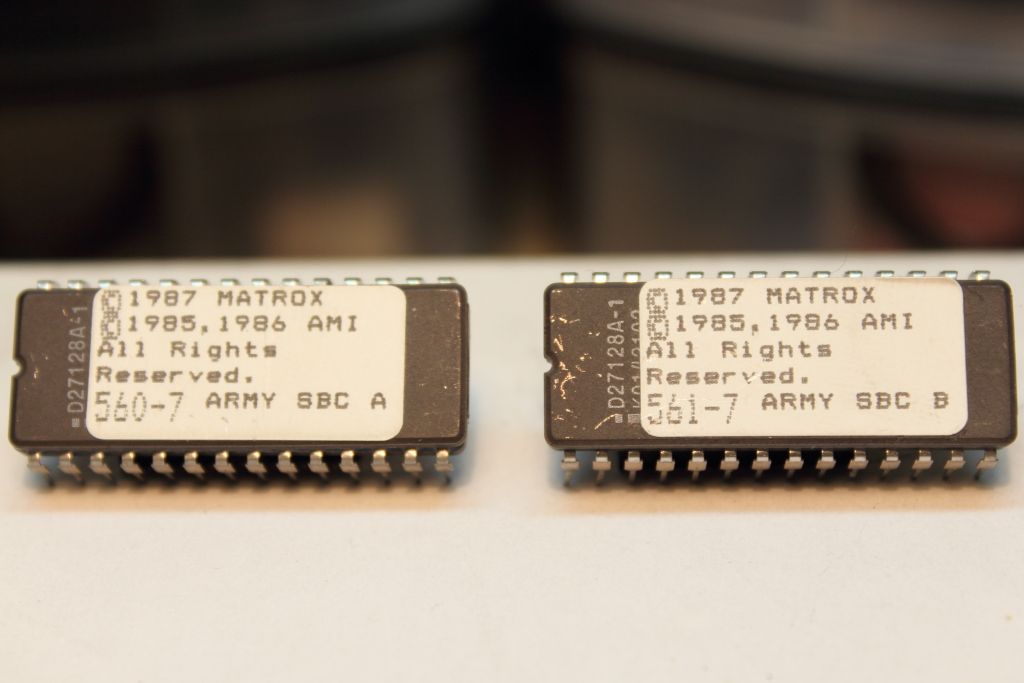

After double checking everything I reinstalled the three boards and my POST card. I really do like how every cable is labled.
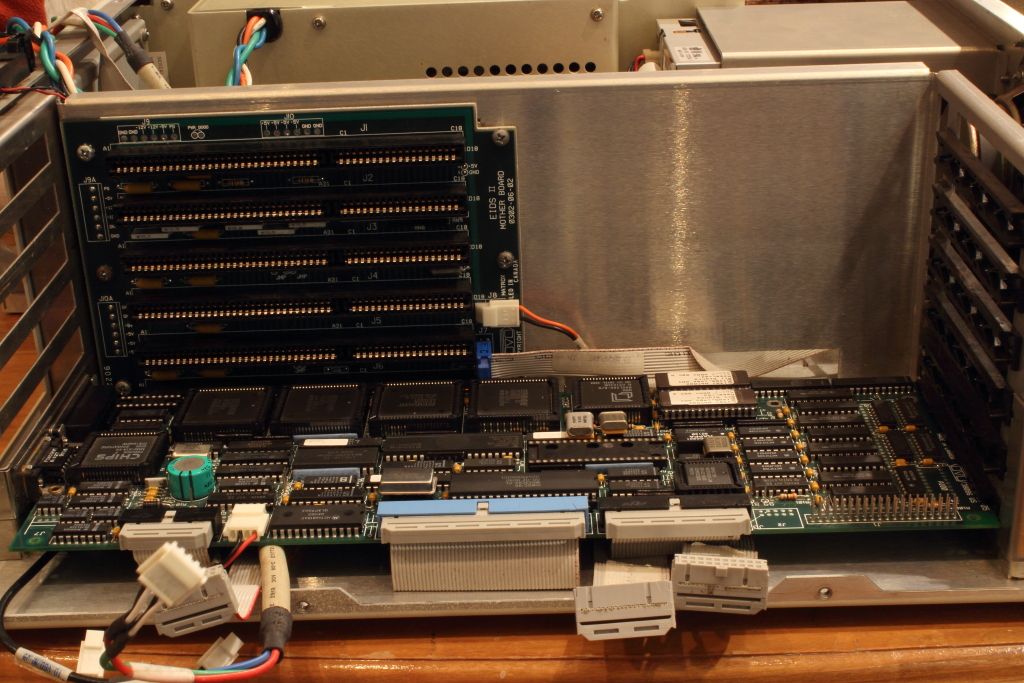

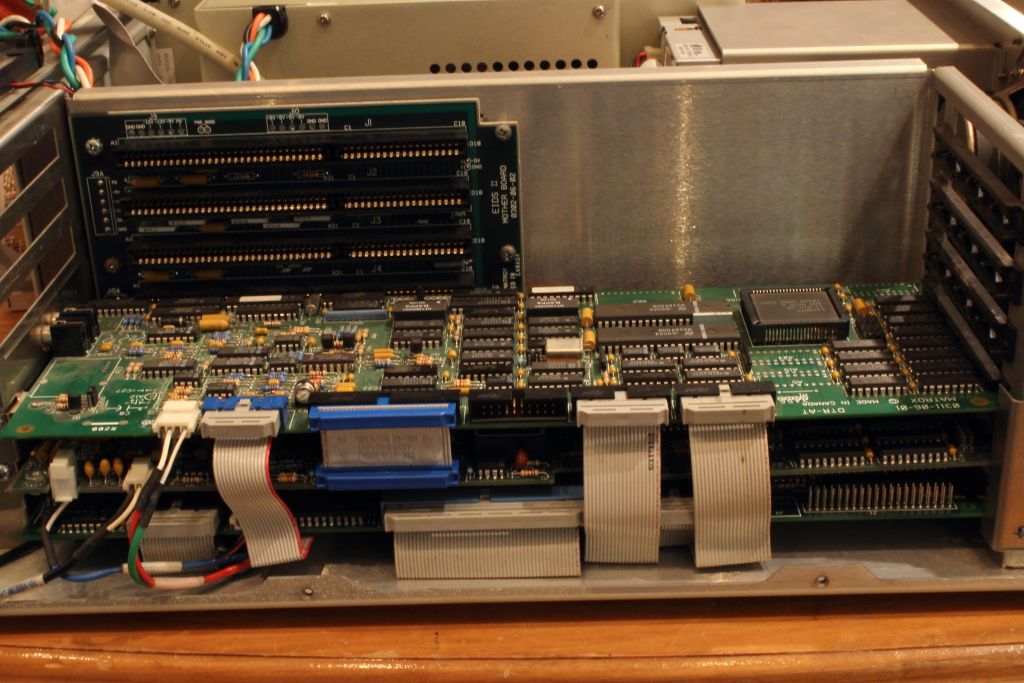
So the switch was flipped and it began rolling through POST codes until hitting at 1A, then we got two long and eight short beeps. I've heard this before when I plugged an incompatible memory card into my 386 machine. It indicates that the video card has either failed or is not present. Not good.
It then proceeded to code 30 again and sat there.
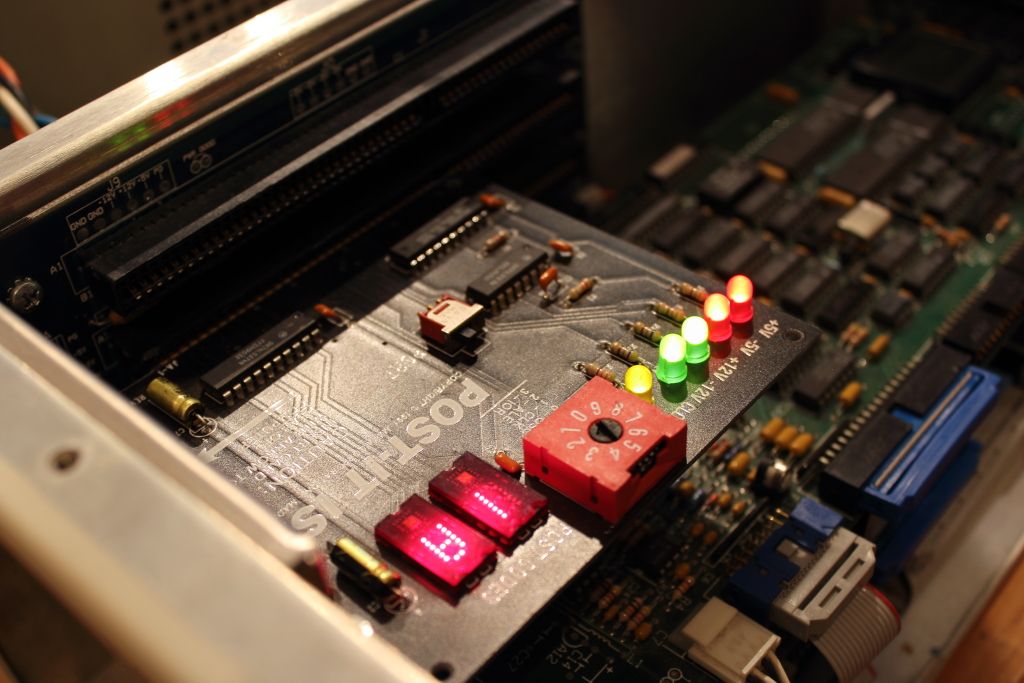
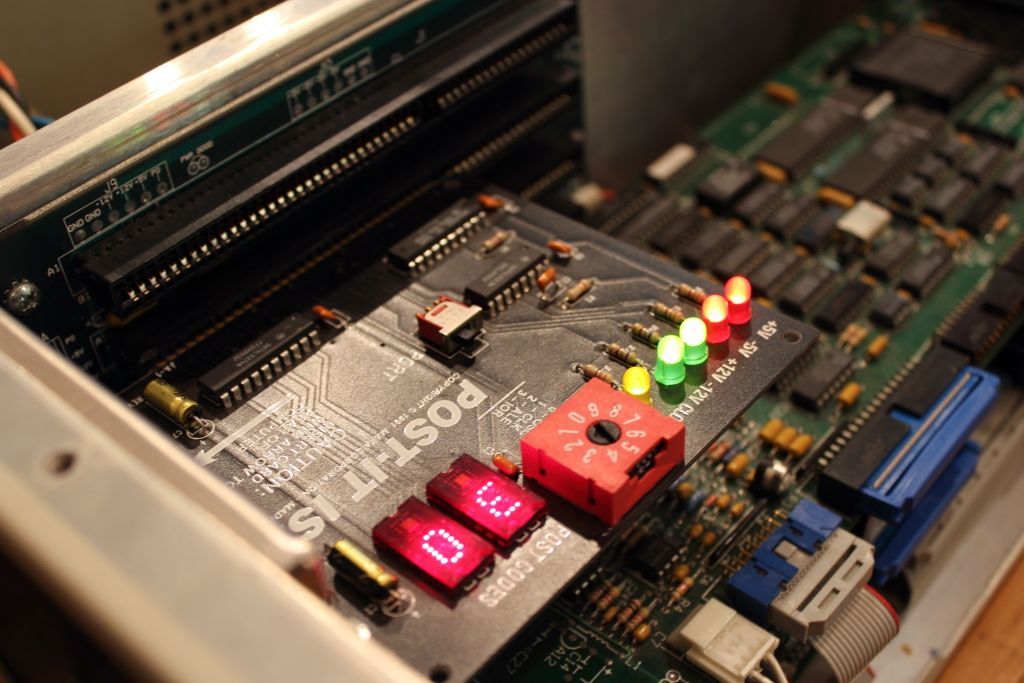
Plugging in another ISA video card did nothing helpful until only the VGO was removed. Once it was out the system was able to successfully POST.
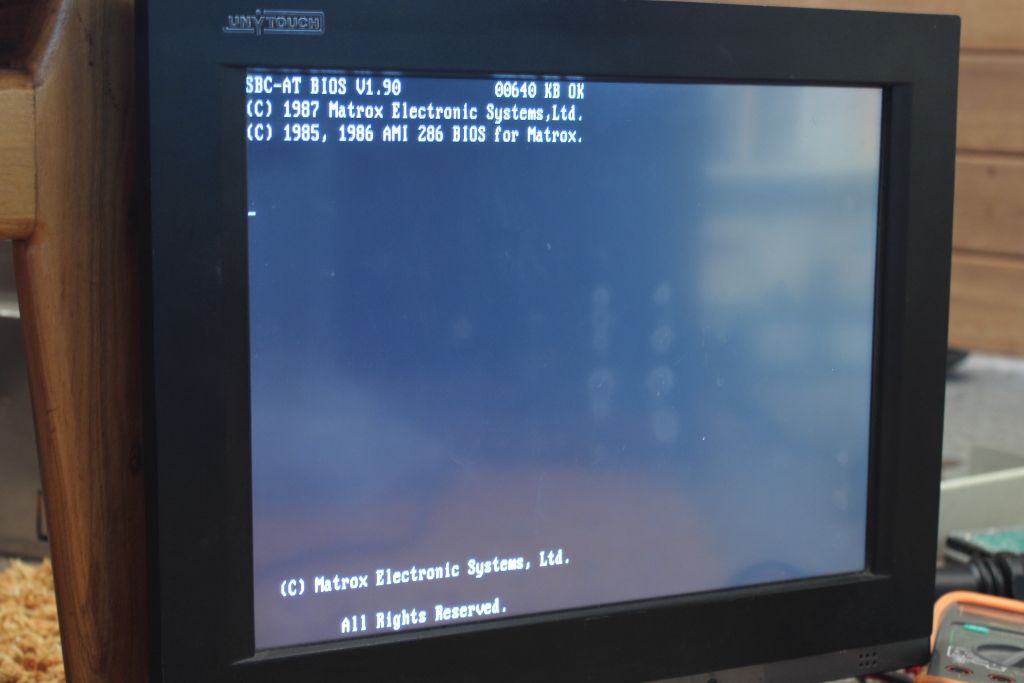
It didn't want to boot from the hard disk as the CMOS needs to be setup and both floppy drives need attention but at least we now know the basic machine works. Unfortunately if the VGO is not present the whole "multimedia" part of the machine is essentially removed and it's just a massive 286. A number of things could be wrong here. The four tantalum capacitors I removed are making it cranky, there's a damaged trace somewhere, there's a failure in a major IC or the EPROM is either bad/suffering from bit rot. The latter two possible causes are worst case. I seem to be the only person around with this machine so there's no replacement parts or sources for a new EPROM image.
Anyways, so I'm going to have to disregard dumping the video BIOS for now simply because I can't figure out exactly how to dump it. For reference though, here's the two chips that contain the system's BIOS and the one D27513 that holds the video BIOS.


After double checking everything I reinstalled the three boards and my POST card. I really do like how every cable is labled.



So the switch was flipped and it began rolling through POST codes until hitting at 1A, then we got two long and eight short beeps. I've heard this before when I plugged an incompatible memory card into my 386 machine. It indicates that the video card has either failed or is not present. Not good.
It then proceeded to code 30 again and sat there.


Plugging in another ISA video card did nothing helpful until only the VGO was removed. Once it was out the system was able to successfully POST.

It didn't want to boot from the hard disk as the CMOS needs to be setup and both floppy drives need attention but at least we now know the basic machine works. Unfortunately if the VGO is not present the whole "multimedia" part of the machine is essentially removed and it's just a massive 286. A number of things could be wrong here. The four tantalum capacitors I removed are making it cranky, there's a damaged trace somewhere, there's a failure in a major IC or the EPROM is either bad/suffering from bit rot. The latter two possible causes are worst case. I seem to be the only person around with this machine so there's no replacement parts or sources for a new EPROM image.
Last edited:
To check the Firmware revision of the unipak press, Select E F Start and note the output, It is upgradable if you can find it but only to V12 on the unipak 2. The later unipack 2B went up to V27.
While you're at it press, Select B 2 Start and note the output, That will check the main 29B unit firmware revision which went up to 6.
While you're at it press, Select B 2 Start and note the output, That will check the main 29B unit firmware revision which went up to 6.
NeXT
Veteran Member
to check the firmware revision of the unipak press, select e f start and note the output.
Code:
fa62 05 **while you're at it press, select b 2 start and note the output, that will check the main 29b unit firmware revision which went up to 6.
Code:
70b3 64k 29b v01Edited:
Looking back on this project it appears we have probably had an issue with with this board all along which isn't any more reassuring that we'll ever get it working. I really do need to find another VGO-AT card. ;_;
Last edited:
